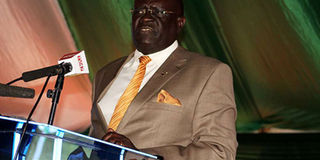Education ministry unveils Sh3 trillion five-year blueprint

Education Cabinet Secretary George Magoha during the Kenya National Examinations Council’s launch of the examination calendar at the Kenya School of Government in Nairobi on October 14, 2019. PHOTO | LUCY MKANYIKA | NATION MEDIA GROUP
What you need to know:
- The report indicates that the education sector is likely to receive, cumulatively, Sh2.32 trillion in budget over the five-year period against the plan cost of Sh3 trillion while donors will pump in Sh666 billion.
- The report costs recurrent requirements at Sh2.68 trillion over the period.
- The government plans to link the sector with industry in order to produce competent graduates.
The Education ministry plans to spend Sh3 trillion in the next five years to increase school enrolment, hire more teachers and boost the quality of learning.
A report dubbed National Education Sector Strategic Plan for the Period 2018-2022 to be unveiled Wednesday in Nairobi by Education Cabinet Secretary George Magoha details how the government intends to address several challenges facing the sector.
“The programmes and their associated activities are projected to cumulatively cost Sh3 trillion over the five-year period, with recurrent costs projected to account for about 90 per cent of the total projected cost,” reads the document.
EMOLUMENTS
The report indicates that the education sector is likely to receive, cumulatively, Sh2.32 trillion in budget over the five-year period against the plan cost of Sh3 trillion while donors will pump in Sh666 billion.
The plan outlines policy priorities, programmes and strategies for the ministry and covers pre-primary, primary, secondary, adult, Technical and Vocational Education and Training (TVET), university, special needs, and teacher education.
The report costs recurrent requirements at Sh2.68 trillion over the period.
“Personnel emoluments constitute the highest share and are projected to cost Sh1.47 trillion, primary education will require Sh104.6 billion in recurrent costs, while secondary education will cost Sh426.3 billion, university education and TVET will cost Sh378 billion and Sh29.8 billion respectively,” reads the document.
PROVIDE LOANS
The government plans to review the differentiated unit cost (DUC) criteria to cater for students admitted under affirmative action and females in science courses as well as provide loans to all students in universities.
Some of the challenges detailed in the report are poor completion rate by learners from primary to secondary schools.
“At the basic education level, there are important sources of internal inefficiencies. For instance, more than 40 per cent of children who start Grade 1 do not go up to Form Four. Also, an estimated one million school going children are out of school, mostly in arid and semi-arid (ASAL) counties,” reads the document.
It adds that there are also wide disparities in access to education based on gender, location and region.
“For instance, girls are generally left behind in ASAL areas. Another aspect is that nearly six out of 10 children from the poorest quintile, who enrolled in Grade 1, are expected to complete Grade 6, compared to nine out of 10 children from the richest quintile.”
CULTURAL PRACTICES
To address the problem, the ministry will strive to address retrogressive cultural practices that prioritise school attendance by boys and require girls to assume domestic responsibilities.
The government also plans to deal with insecurity, provide sanitary towels to girls and address school dropout and teenage pregnancies.
The plan notes that more children at the basic education level don’t learn adequately, with less than 20 per cent of KCSE exam candidates scoring C+ and above over the last two academic years, which is the entry qualification for university education.
“An efficient and effective secondary education will require that all stakeholders are aligned towards the goal of safe and equitable learning for girls and boys alike. There is, therefore, the need to have a clear focus, cultivate a collaborative culture, deepen learning and secure accountability in secondary education,” the plan reads.
ENROLMENT
The government will also raise the net enrolment rate (NER) from the current 91.2 per cent to 93.1 per cent in primary schools by the year 2022.
In secondary schools, it plans to reduce disparities based on gender, disability, location (rural/urban) and region in access to secondary education by 2022.
At TVET, challenges include inadequate data, low enrolment among females, poor linkages with the industry, inadequate physical infrastructure and equipment to support the teaching of the Competency Based Education and Training (CBET) curriculum, non-alignment of the curriculum to the CBET curriculum and to the Vision 2030, among others.
The government plans to link the sector with industry in order to produce competent graduates.
University sub-sector challenges include inadequate funding, low proportion of Science Engineering and Technology (Set) subjects, low enrolment of female students in Stem subjects, and inadequate qualified teaching staff.
TEACHER SHORTAGE
On teachers, the document indicates that the Teachers Service Commission manages a working force of 313,542 teachers deployed to 30,892 public basic educational institutions in the country.
These include 215,367 teachers serving in 22,263 public primary schools and 98,175 teachers serving in 8,629 public post-primary institutions.
The plan says there is an overall teacher shortage of 96,345 and which includes 38,054 at the primary school level and 58,291 at the post primary school level.





